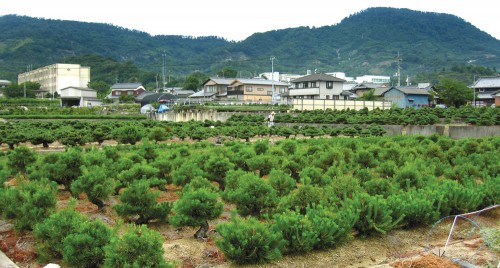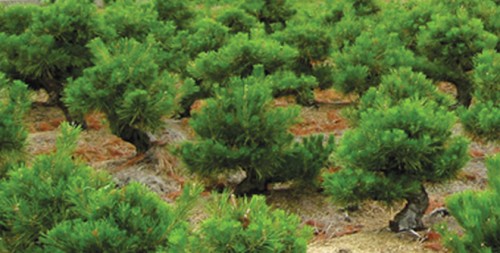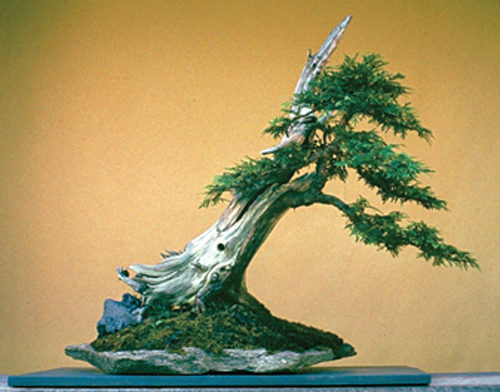
Have you tried field growing? You don’t need a lot of space to experiment with a small number of plants and the results will easily exceed expectations that have been conditioned by container growing.

One of the reasons the Japanese have so many well developed bonsai is field growing. In the west, we tend to grow bonsai stock in containers. In Japan, most stock is field grown; you’ve no doubt noticed the strikingly powerful Japanese Black Pines in the two photos above (from Morten Albek’s Shohin Bonsai). Though I don’t know how old those massive trunks are, my best guess is they are around fifteen or so, even though they look much, much older.
I used to grow all my stock in containers, now I grow almost all in the field, or more accurately, in my yard. I just incorporate them into my landscaping (some will no doubt just stay there), which tends to be Japanese influenced with a certain rocky Vermont feel. Lots of junipers and dwarf and miniature conifers cultivars, as well as collected larch, spruce, cedars, maples, balsam fir, hemlocks and others. Right now, I have about a hundred potential bonsai in the ground and hundreds more planned (eight acres helps).

So far, the larch (Larix laricina) are the most responsive, with rapidly expanding trunks and plentiful branching (the Larch above is from the cover of Nick Lenz’s Bonsai from the Wild; it was originally collected in the wild, so you could say it was field grown by Mother Nature). Larch love water and no doubt respond to my compulsive watering disorder. The soil here is very sandy, and the land is almost floating on water with several springs, a natural pond and a very generous drilled well. When Al’s big drought comes, we’ll be the last to know it.
One disadvantage to plentiful watering is leaching nutrients out of the soil. My solution is to top dress with partially broken down cedar mulch and to add plenty of local organic fertilizer. Fresh wood chips rob the soil of nitrogen (which they give back later when they break down) so it’s best to wait until they’ve aged a couple years before you use any.
I plan to feature field growing fairly regularly, so stay tuned. I’d like to show you some pictures, but right now everything is hidden under an impressively thick white blanket. In about three months the action starts and I’ll post some photos then.
Meanwhile, it’s not too early to start planning for the spring.
I will welcome any info I can get. I already have my own bonsai nursery going.
Do you have any comments on some of the considerations to getting started field growing? Soil preparation, initial styling, nebari development, things to watch out for, etc. ?
I like the idea of incorporating the field plantings into the landscape around the house. I have 5 pretty well developed junipers in the terraces around a pool. They are a little over 30 years old with very nice trunks. I plan to dig up two of them this year. Hope they don’t croak! I also have three 10yr old pyracantha that are being replace in front of the house. These should provide nice material as well.I look forward to other comments on the subject. Thanks for starting the blog, Wayne.
I have attached a web link to a http://www.bonsaisouth.com.au which has some good shots of field growing in the Southern Highlands of NSW Australia.
This is definately the way to surge your tree’s ahead, ie tub grown ficus in the temperatate climate of NSW grow at an excetable rate but if you ground them you can expect all year growth of 200 to 300% above tub raised trees.
Wayne,
Nice to see this up and running!
Irene
I am experimenting with field growing bonsai. I have noticed that some trees respond better than others, even of the same species. Some thiken up nicely and quickly, some just sit. A problem with field growing is that sometimes the trees “run away” from you. They send roots down deep making thenm difficult to harvest. Some people plant the starter trees on something flat like a plastic icecream lid, or the plastic lids from baby milk cans. Others use wood, tiles, old saucers. This sends the roots out sideways before they go down, enhancing harvestability and improving nebari. Some people use plastic colanders, or drill holes in black platic basins; then plant the whole lot in the ground. The root ball stays in the basins while some roots “escape” through the holes and thiken the tree much faster. Ive seen some guys cut half of the roots emerging from the basin in one season and then the other half next season, especially when trees have very agressive roots, like figs and accacia. I would like to know if anyone has a “trick” that can enhance taper while field growing.
Thank you all for getting in touch and for your kind encouragement.
Karl, I think Roger’s post might help with some of your questions. Stay posted and there will be more coming up. Meanwhile, some people swear by raised beds (I make landscaped mountains and hills instead), and good soil helps, but there are right ways and not so right ways to prepare soil, which we’ll get into soon. Meanwhile, if anyone out there has any tips, feel free.
Ed, one tip for digging is to do your top pruning and thinning at the same time you dig. The more foliage you remove (within reason) the less the newly stressed roots will have to support.
Thanks again,
Wayne
In response to Ed’s post, couldn’t you also do as if you were transplanting any older tree or shrub… the year before, spade around the rootball to cut the big roots and encourage finer rooting for the next year so that when you do dig it up, it does have a better chance to survive? I have been comtemplating doing raised beds for my “potensai” because the soil is so hard and compacted here. Thoughts,
brian
I am using cedar chips too, around plants. I tried using adding pine bark to my bonsai soil, which had broken down after about 2-3 years, until I looked down at the soil, and saw some big mealy worms. I’m not sure if they eat roots or not, but dont care to find out. Maybe if you use just a BIT of shredded cedar in your construct, wont some nitrogen heavy fertilizer compensate for the breakdown?